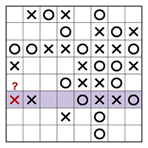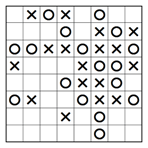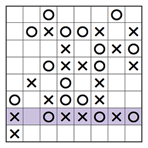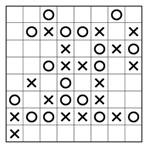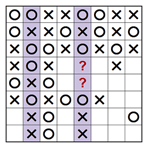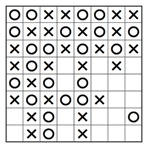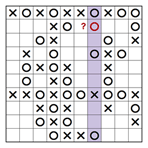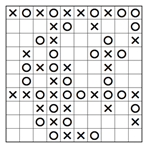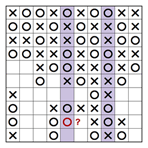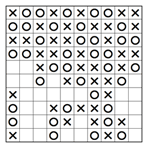Binoxxo is a single-player puzzle based on Tic-Tac-Toe, a game that many of us loved as children. Each puzzle consists of a grid with the letters X and O in different places. The aim is to fill the remaining boxes with X and O in such a way that each column or row never contains more than two consecutive X or O and that all rows and columns are unique. In the example below we have a Binoxxo puzzle (6×6) with six rows and six columns. We now have to put X and O in the remaining boxes according to the rules … but how?
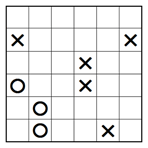
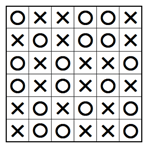
Basic Techniques
Binoxxo puzzles begin with some very simple steps based on the 1st rule, which states that no more than two consecutive Xs or Os may appear in a row or column. Further simple steps follow according to the 2nd rule, according to which the number of X and O in a row or column must be the same, and according to the 3rd rule, which requires that no row or column be the same as another. Here are some examples of how to use these basic techniques:
1. Avoid three identical consecutive letters 1
Most Binoxxo puzzles start with some predefined XX and OO pairs in different places. Since no more than two consecutive Xs or Os are allowed, we can place the other letter next to each other directly on both sides, as the example below shows.
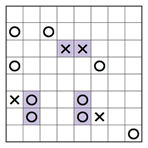
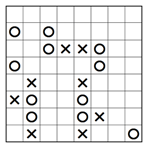
2. Avoid three identical consecutive letters 2
Another common situation is X_X and O_O, where two equal letters are separated by an empty box. Again, we can enter the other letter directly into the box in the middle to avoid three consecutive identical letters, as shown in the example below.
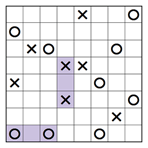
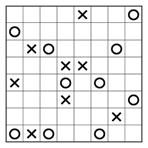
3. Avoid three identical consecutive letters 3
Sometimes an X or O cannot be placed in a box because it would cause a forbidden triple combination one or two steps later. Let’s look at row 6 of the partially solved puzzle below. If we place an X in the left box, then the other two empty boxes must each contain an O, according to the rule that each row or column must contain the same number of Xs and Os.
4. Complete a row or column
According to the second rule, the number of X and O in each row or column must be the same. This means that in an 8×8 puzzle each row or column should contain four Xs and four Os. If we now look at the highlighted row of the partially solved puzzle below, we see four Xs and only three Os, so an O must be placed in the empty box.
5. Prevent two identical rows or columns
The third rule of Binoxxo says that no two rows or columns may be identical. In the partially solved puzzle below we see two highlighted columns, one complete and one with two empty boxes. Since the incomplete one lacks an X and an O, there is only one way to place them without creating a second identical row, as the second picture below shows.
Advanced Techniques
The techniques described so far are not sufficient to solve difficult puzzles. For these you need brains and advanced techniques to work out many special and interesting logical situations. Advanced techniques are based on a process of conjecture and conflict in which one assumes that a box contains an X (or O), and in the next step this conjecture turns out to be false by pure logical combination. Here are some examples of advanced techniques to solve special situations. You will develop many more yourself if you solve a Binoxxo puzzle yourself:
1. Advanced technique 1
Let’s have a look at the highlighted column in the partially solved puzzle below. If we place an O in the second box from above, then we have placed four of the five O in this column, which means that one O is still missing. However, each box in which we try leads to XXX in some places. This means that the second box from the top must contain an X, as the example on the right shows below.
2. Advanced Technique 2
Sometimes advanced techniques are needed to prevent two identical rows or columns from forming. In the partially solved puzzle below we see two highlighted columns, one complete and the other with three empty boxes. Let’s see what happens when we put an O in the second box from below. Because there are already four O in this column, we would have to place an X in each of the two empty boxes in order to get the same number of X and O. The number of X and O in this column is the same. However, this would lead to two identical columns, which is not allowed according to the rules. For this reason, the second box must contain an X from below.



